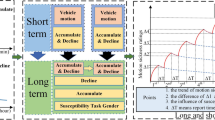Abstract
The introduction of autonomous vehicles is expected to change the transportation system radically. One of the essential factors that affect the acceptance and choice of autonomous driving is passenger comfort. All people in the autonomous vehicle will be passengers and be able to perform non-driving tasks like reading etc. which increases the likelihood of motion sickness. This makes accurate estimation of motion sickness a necessity in the design stages of autonomous vehicles. The aim of this work is to review and apply two motion sickness prediction models (ISO-2631 and the 6D-SVC model) and evaluate their ability to capture individual motion sickness feelings using measured data and subjective assessment ratings from field tests. The comparison with the experimental results shows that the applied estimation models can be tuned to capture the individual motion sickness feelings. The results also show that habituation of motion sickness is an important property that needs to be taken into consideration and modelled.
Access this chapter
Tax calculation will be finalised at checkout
Purchases are for personal use only
Similar content being viewed by others
References
Kuiper, O.X.: Driven to the future: Carsickness in autonomous vehicles, PhD thesis, Vrije Universiteit Amsterdam (2019)
Sivak, M., Schoettle, B.: Motion sickness in self-driving vehicles. Trans. Res. Inst., Univ. MI, Ann Arbor, MI, USA, Technical report UMTRI2015-12 (2015)
Rolnick, A., Lubow, R.E.: Why is the driver rarely motion sick? The role of controllability in motion sickness. Ergonomics 34(7), 867–879 (1991)
Diels, C., Bos, J.E.: Self-driving carsickness. Appl. Ergon. 53, 374–382 (2016)
Iskander, J., Attia, M., Saleh, K., et al.: From car sickness to autonomous car sickness: a review. Transport. Res. F Traffic Psychol. Behav. 62, 716–726 (2019)
Yunus, I., Jerrelind, J., Drugge, L.: Autonomous driving and motion sickness – an outlook on causes, evaluation methods and solutions. Resource Efficient Vehicles Conference: rev2021, Stockholm, Sweden (2021)
Golding, J.F.: Motion sickness susceptibility questionnaire revised and its relationship to other forms of sickness. Brain Res. Bull. 47(5), 507–516 (1998)
Gianaros, P.J., Muth, E.R., Mordkoff, J.T., et al.: A questionnaire for the assessment of the multiple dimensions of motion sickness. Aviat. Space Environ. Med. 72(2), 115–119 (2001)
Bos, J.E., MacKinnon, S.N., Patterson, A.: Motion sickness symptoms in a ship motion simulator: effects of inside, outside, and no view. Aviat. Space Environ. Med. 76(12), 1111–1118 (2005)
Lewkowicz, R.: Modeling motion sickness. Polish J. Aviat. Med. Bioeng. Psychol. 22(3), 32–42 (2017)
O’Hanlon, J.F., McCauley, M.E.: Motion sickness incidence as a function of the frequency and acceleration of vertical sinusoidal motion. Aerosp. Med. 45(4), 366–369 (1974)
McCauley, M.E., et al.: Motion sickness incidence: exploratory studies of habituation, pitch and roll, and the refinement of a mathematical model. Human Factors Research Incorporated, Technical report, no. 1733-2 (1976)
Lawther, A., Griffin, M.J.: Prediction of the incidence of motion sickness from the magnitude, frequency, and duration of vertical oscillation. J. Acoust. Soc. Am. 82(3), 957–966 (1987)
ISO 2631-1: Vibration and shock–Evaluation of human exposure to whole-body vibration, pp. 8–30 (1997)
Reason, J.T.: Motion sickness adaptation: a neural mismatch model. J. R. Soc. Med. 71(11), 819–829 (1978)
Oman, C.M.: A heuristic mathematical model for the dynamics of sensory conflict and motion sickness. Acta Otolaryngol. 94(sup392), 4–44 (1982)
Irmak, T., Pool, D.M., Happee, R.: Objective and subjective responses to motion sickness: the group and the individual. Exp. Brain Res. 239(2), 515–531 (2021)
Bos, J.E., Bles, W.: Modelling motion sickness and subjective vertical mismatch detailed for vertical motions. Brain Res. Bull. 47(5), 537–542 (1998)
Braccesi, C., Cianetti, F.: Motion sickness. Part I: development of a model for predicting motion sickness incidence. Int. J. Hum. Factors Modell. Simul. 2(3), 163–187 (2011)
Wada, T., Kamij, N., Doi, S.: A mathematical model of motion sickness in 6DOF motion and its application to vehicle passengers, preprint arXiv:1504.05261 (2015)
Wada, T., et al.: A computational model of motion sickness considering visual and vestibular information. In: 2020 IEEE International Conference on Systems, Man, and Cybernetics (SMC), pp. 1758–1763 (2020)
Braccesi, C., Cianetti, F., Elia, A.: Motion sickness. Part II: experimental verification on the railways of a model for predicting motion sickness incidence. Int. J. Hum. Factors Modell. Simul. 2(3), 188–203 (2011)
Kamiji, N., et al.: Modeling and validation of carsickness mechanism. In: SICE Annual Conference 2007, pp. 1138–1143 (2007)
Donohew, B.E., Griffin, M.J.: Motion sickness: effect of the frequency of lateral oscillation. Aviat. Space Environ. Med. 75(8), 649–656 (2004)
Griffin, M.J., Mills, K.L.: Effect of frequency and direction of horizontal oscillation on motion sickness. Aviat. Space Environ. Med. 73(6), 537–543 (2002)
Kufver, B., Förstberg, J.: A net dose model for development of nausea. Swedish National Road and Transport Research Institute, Linköping, VTI särtryck 330 (1999)
Maculewicz, J., Larsson, P., Fagerlönn, J.: Intuitive and subtle motion-anticipatory auditory cues reduce motion sickness in self-driving cars. Int. J. Hum. Factors Ergon. 8(4), 370–392 (2021)
Acknowledgments
The authors would like to thank the Centre for ECO2 Vehicle Design, funded by the Swedish Innovation Agency Vinnova (Grant Number 2016-05195), and Volvo Cars for financial support. A special thanks also to Britta Berg and Willy Tunbratt at Volvo Cars.
Author information
Authors and Affiliations
Corresponding author
Editor information
Editors and Affiliations
Rights and permissions
Copyright information
© 2022 The Author(s), under exclusive license to Springer Nature Switzerland AG
About this paper
Cite this paper
Yunus, I., Jerrelind, J., Drugge, L. (2022). Evaluation of Motion Sickness Prediction Models for Autonomous Driving. In: Orlova, A., Cole, D. (eds) Advances in Dynamics of Vehicles on Roads and Tracks II. IAVSD 2021. Lecture Notes in Mechanical Engineering. Springer, Cham. https://doi.org/10.1007/978-3-031-07305-2_81
Download citation
DOI: https://doi.org/10.1007/978-3-031-07305-2_81
Published:
Publisher Name: Springer, Cham
Print ISBN: 978-3-031-07304-5
Online ISBN: 978-3-031-07305-2
eBook Packages: EngineeringEngineering (R0)




